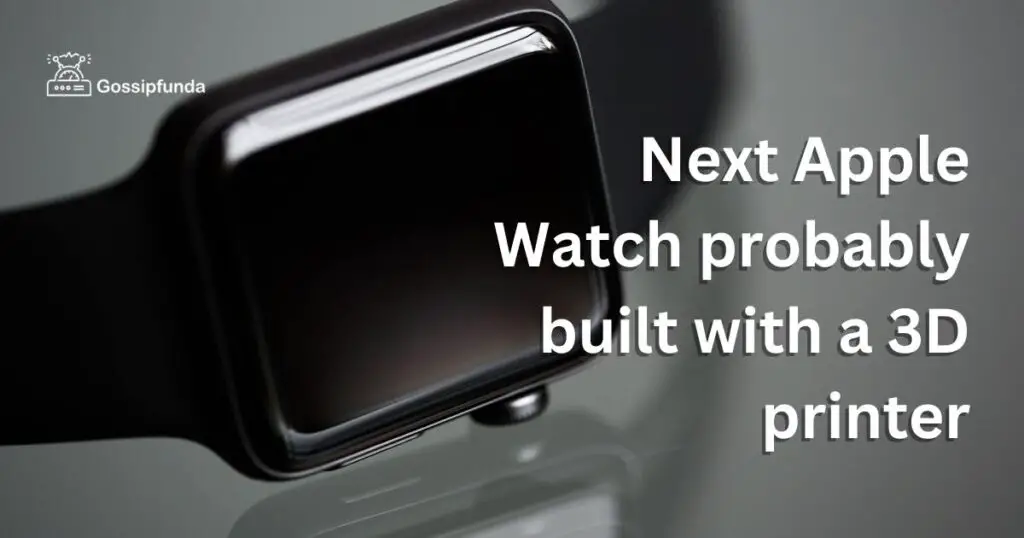Innovation knows no bounds, and the tech giant Apple is once again pushing the envelope with its upcoming product, the Apple Watch Series 9. While consumers eagerly anticipate the launch of the iPhone 15 and iPhone 15 Pro, it’s the whispers about a revolutionary manufacturing process that’s capturing the attention of tech enthusiasts. The buzz centers around Apple’s potential use of 3D printing technology to craft its next-gen Apple Watches. This paradigm shift could not only reshape the wearables industry but also reinforce Apple’s commitment to sustainability, efficiency, and cutting-edge design.

The Evolution of 3D Printing
The evolution of 3D printing has been a journey marked by significant advancements and technological breakthroughs. Here’s a detailed exploration of the steps that have shaped the progression of 3D printing:
- Inception of Additive Manufacturing: The concept of 3D printing, also known as additive manufacturing, was first conceived in the 1980s. This novel approach aimed to create three-dimensional objects by layering material upon material, in contrast to traditional subtractive methods.
- Early Prototyping and Industrial Use: The initial applications of 3D printing were primarily in rapid prototyping for industries like automotive, aerospace, and medical. Engineers used the technology to quickly create physical prototypes, enabling faster design iterations and reducing development time.
- Wider Material Compatibility: In its early stages, 3D printing primarily focused on plastics. However, advancements in material science expanded the possibilities. Materials such as metals, ceramics, and even food ingredients became compatible with 3D printers, broadening the range of potential applications.
- Consumer Accessibility: As patents for key 3D printing technologies expired, the technology became more accessible to consumers and small businesses. Desktop 3D printers entered the market, allowing hobbyists, artists, and entrepreneurs to experiment with creating their designs.
- Medical and Bioprinting: The medical field embraced 3D printing for creating patient-specific implants, surgical guides, and even artificial organs. Bioprinting, a specialized application, emerged, enabling the printing of living tissue and organs using specialized bio-inks.
- Mass Customization and Production: 3D printing’s ability to create intricate and customized designs led to its use in producing small batches of complex products, from jewelry to industrial components. This shift marked a departure from traditional mass production techniques.
- Advancements in Speed and Scale: Over time, 3D printing technologies evolved to become faster and capable of producing larger objects. Innovations like Continuous Liquid Interface Production (CLIP) and high-speed sintering revolutionized the speed and scalability of 3D printing.
- Integration of AI and Machine Learning: Artificial intelligence and machine learning technologies are being integrated into 3D printing processes, optimizing designs for strength and efficiency, predicting potential printing failures, and enhancing overall print quality.
- Sustainability and Eco-Friendly Materials: As environmental concerns grew, 3D printing adopted sustainable practices. Companies began experimenting with recycled materials and bio-based filaments, aligning with eco-friendly manufacturing trends.
- Multi-Material and Multi-Color Printing: Advancements allowed for simultaneous printing with multiple materials and colors. This opened doors to more intricate designs, functional prototypes, and artistic creations.
- Industry 4.0 Integration: 3D printing became an integral part of Industry 4.0, the fourth industrial revolution characterized by smart factories and automation. It facilitates on-demand production, reduces inventory costs, and enhances supply chain resilience.
- Space Exploration and Beyond: The ultimate frontier for 3D printing is space exploration. NASA and other space agencies are exploring the use of 3D printing to create tools, habitats, and even spare parts in space, reducing the need for costly Earth-bound shipments.
The evolution of 3D printing spans decades of innovation, bringing about transformative changes in various industries. From rapid prototyping to customized production, the journey showcases the remarkable adaptability and potential of additive manufacturing. As technology continues to evolve, the future promises even more exciting possibilities for 3D printing.
Don’t miss: Apple update error
Unveiling the Advantages
Imagine a manufacturing process that not only accelerates production but also reduces costs and minimizes resource consumption. That’s precisely what Apple is aiming for with its experimentation in 3D printing. The new method promises to streamline production processes, potentially allowing for faster market releases and reduced production downtime. This shift could lead to substantial savings for Apple while enhancing its commitment to sustainability through efficient resource utilization.
A Game Changer for Apple
While the end consumer might not perceive an immediate difference in the final product, the implications for Apple are profound. Boldly stepping into the realm of 3D printing showcases Apple’s determination to innovate, regardless of how mature the industry might be. It demonstrates the brand’s resolve to optimize its production pipeline and explore new horizons in manufacturing. Notably, the transition to 3D printing won’t be abrupt; Apple plans to gradually adopt the new technique, with the Apple Watch Series 9 and Apple Watch Ultra 2 being the first beneficiaries.
Sustainability Front and Center
In a world where environmental consciousness is becoming increasingly critical, Apple’s foray into 3D printing is more than just a technical leap. The new manufacturing process aligns with Apple’s broader sustainability efforts. By reducing waste and optimizing material usage, the company can contribute to a greener future. This strategic move reaffirms Apple’s commitment to responsible corporate practices, capturing the hearts of consumers who value eco-friendliness.
Years in the Making
Transitioning to 3D printing isn’t an overnight endeavor. Reports suggest that Apple has dedicated substantial time and effort—upwards of three years—to perfecting this manufacturing method. This prolonged investment underscores the complexity and significance of the shift. Apple’s meticulous approach aims to ensure that the end product maintains its hallmark quality, while the new manufacturing process enhances efficiency and cost-effectiveness.
The Future Beyond Watches
The potential of 3D printing extends far beyond the realm of watches, ushering in a new era of innovation and transformation across diverse industries. Here’s a detailed look at the future possibilities that lie beyond 3D-printed watches:
- Customized Medical Devices: 3D printing holds immense promise for producing personalized medical implants, prosthetics, and orthotics. Patient-specific designs can enhance comfort, fit, and functionality, improving the quality of life for individuals.
- Aerospace Advancements: The aerospace industry can leverage 3D printing to manufacture lightweight, complex components with reduced material waste. This technology can accelerate the production of aircraft parts and even facilitate the creation of components for space exploration.
- Automotive Revolution: Car manufacturers can harness 3D printing to produce intricate and lightweight vehicle components. This could lead to improved fuel efficiency, reduced emissions, and enhanced overall performance.
- Architecture and Construction: The construction sector can benefit from 3D printing by creating intricate architectural designs and structures with precision. Large-scale 3D printers can potentially construct buildings using sustainable materials.
- Art and Design: Artists and designers can explore new creative horizons by incorporating 3D printing into their projects. Sculptures, jewelry, and fashion items can be produced with unprecedented intricacy and uniqueness.
- Food and Culinary Delights: 3D food printing might redefine culinary experiences, enabling chefs to create intricate and visually appealing dishes. Customized nutrition, intricate cake decorations, and complex chocolate sculptures are just the beginning.
- Educational Tools: Educational institutions can use 3D printing to create interactive and tactile learning aids. Students can better grasp complex concepts through hands-on experiences with physical models.
- Environmental Conservation: 3D printing can aid in environmental conservation efforts by producing replacement parts for appliances, electronics, and machinery, extending the lifespan of products and reducing e-waste.
- Consumer Electronics: The electronics industry could benefit from 3D-printed circuit boards, housings, and other components. This could lead to faster prototyping, reduced material waste, and more efficient designs.
- Jewelry and Accessories: The jewelry industry can create intricate and personalized pieces using 3D printing, allowing for unique designs tailored to individual preferences.
- Innovative Footwear: Footwear companies can use 3D printing to create custom-fit shoes that provide enhanced comfort and support, reducing the need for excess inventory.
- Renewable Energy Solutions: 3D printing can be utilized to manufacture components for renewable energy systems, such as wind turbines and solar panels, contributing to sustainable energy generation.
- Entertainment and Gaming: 3D-printed collectibles, game figurines, and props for movies and video games can enhance the entertainment experience for enthusiasts.
- Tool and Equipment Manufacturing: Industries that rely on specialized tools and equipment can benefit from 3D printing to produce customized solutions that enhance efficiency and productivity.
- Environmental Monitoring Devices: Customized sensors and monitoring devices can be 3D-printed for various environmental applications, contributing to data collection and analysis for research purposes.
The future beyond 3D-printed watches holds a world of endless possibilities. The technology’s versatility and adaptability make it a powerful tool for revolutionizing various industries and shaping a more efficient, sustainable, and creative world. As advancements continue, the boundaries of what can be achieved with 3D printing are continually expanding, sparking excitement and innovation across the globe.
Conclusion
As the world awaits Apple’s much-anticipated September event, the spotlight isn’t solely on the new iPhones. The potential debut of 3D-printed Apple Watches promises to be a game changer in the tech industry. Apple’s calculated move toward integrating 3D printing showcases its determination to continuously evolve and redefine manufacturing norms. With sustainability at the forefront, this shift also demonstrates Apple’s dedication to reducing its ecological footprint. While the transition might be gradual, the implications are far-reaching, with the promise of a more innovative, efficient, and eco-conscious future for both Apple and the technology landscape as a whole.
FAQs
Apple’s creating a stir with its 3D-printed watches, a leap in innovation.
It revolutionizes manufacturing, making it faster, greener, and more efficient.
Initially, yes, but Apple’s eyeing wider applications if successful.
Speedier production, cost savings, and minimal resource wastage, boosting sustainability.
Not at all. Apple’s dedicated years to perfecting this advanced manufacturing process.
Prachi Mishra is a talented Digital Marketer and Technical Content Writer with a passion for creating impactful content and optimizing it for online platforms. With a strong background in marketing and a deep understanding of SEO and digital marketing strategies, Prachi has helped several businesses increase their online visibility and drive more traffic to their websites.
As a technical content writer, Prachi has extensive experience in creating engaging and informative content for a range of industries, including technology, finance, healthcare, and more. Her ability to simplify complex concepts and present them in a clear and concise manner has made her a valuable asset to her clients.
Prachi is a self-motivated and goal-oriented professional who is committed to delivering high-quality work that exceeds her clients’ expectations. She has a keen eye for detail and is always willing to go the extra mile to ensure that her work is accurate, informative, and engaging.


